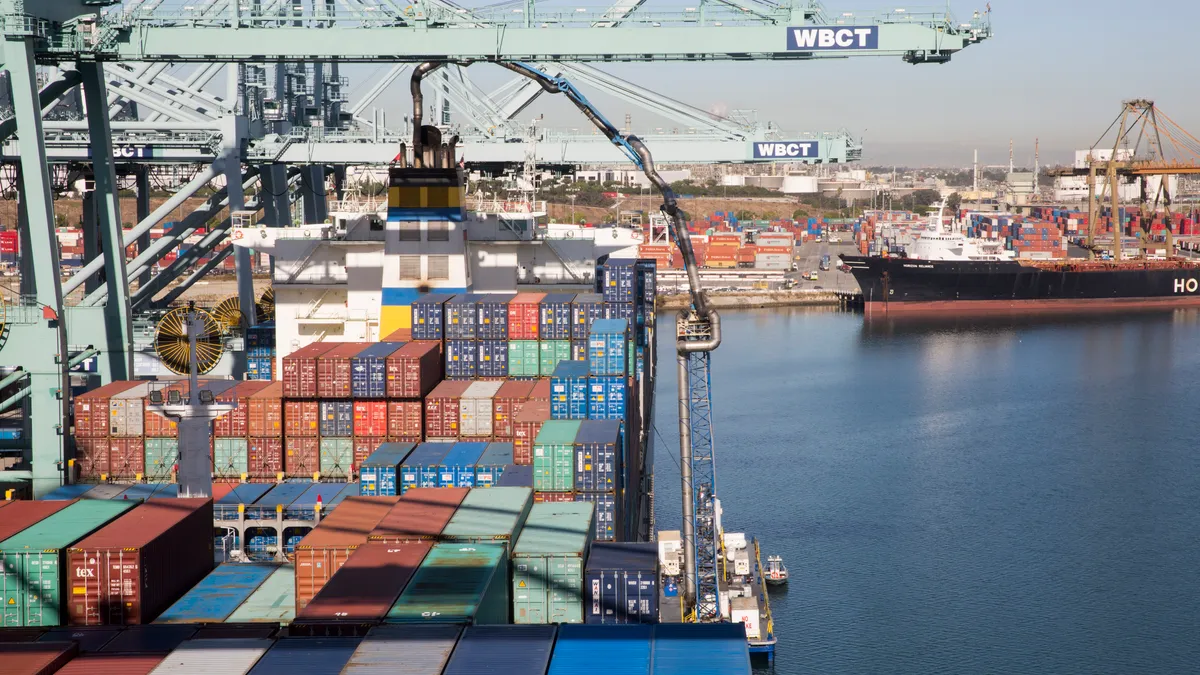Dive Brief:
- TEU moves at the Port of Los Angeles dropped 22.9% year-over-year (YoY) in February, due to the impact of the COVID-19 outbreak on factory operations in Asia, according to a press release on Tuesday. The port expects volumes to continue to decline in March.
- "Looking ahead to anticipated manufacturing improvements, we will need to return empty containers to Asia and push lingering U.S. export boxes out swiftly," Port of Los Angeles Executive Director Gene Seroka said in the release. "We’re actively working with our supply chain partners to be prepared for a cargo surge once production levels ramp up."
- As of Tuesday, the port is maintaining normal operations and says "there are no reports of any vessel crew members displaying symptoms of the coronavirus." The Centers for Disease Control and Prevention (CDC) is monitoring 157 confirmed cases in the state.
Dive Insight:
The impact of coronavirus-related disruptions on global supply chains has compounded the already declining volumes the Port of Los Angeles was experiencing due to the U.S.-China trade war.
After a record year in 2018 when shippers pulled forward inventory to stockpile ahead of the tariffs, the Trump administration levied additional, more expansive tranches throughout 2019, bringing the port's total volume growth for the year to 0.4% after a disappointing peak season.

"As we expected, 2019 winds down with volumes weakening, due largely to the U.S.-China trade war which continues to negatively impact American consumers, manufacturers and U.S. supply chain jobs," Seroka said in a statement in December. "Although we anticipate tariffs will linger well into 2020, we will continue to aggressively invest in our physical and digital infrastructure through this economic cycle."
The coronavirus outbreak has since caused more than 56 canceled sailings at the ports of Los Angeles and Long Beach, California, the ports told Supply Chain Dive, which has driven up the number of inactive TEUs and begun to negatively affect port labor as operations remain slow.
There are signs volume could soon pick back up.
The number of Trans-Pacific and Asia-Europe blank sailings is returning to normal levels, according to a report from Sea-Intelligence emailed to Supply Chain Dive. Shippers will now have to anticipate the additional time needed for carriers and ports to work through backlogged orders.
"Back haul freight rates are beginning to increase as carriers increasingly favor empty repositioning for the limited back haul sailings ... [and move] to capture what is expected to be a peak in Chinese exports in the medium-term future," which could push rates even higher, according to the report.
Some relief could come in the form of reduced fuel prices amid global market uncertainty. Sea-Intelligence found that while higher IMO 2020-compliant, low-sulfur, fuel-oil prices were a major concern for shippers going into 2020, "low-Sulphur fuel prices are dipping below the levels for normal fuel last year. Furthermore, the sudden price war on oil has the potential to send fuel prices back to levels seen in 2015/16 and hence make the cost of low-Sulphur fuel the least of the carriers’ problems."
As factory and port operations in China return to normal, economists and freight market-watchers are concerned a secondary downturn could be on the horizon whereby shippers will experience curtailed demand as the COVID-19 outbreak spreads to other parts of the world, causing another unpredictable wave of disruption.













